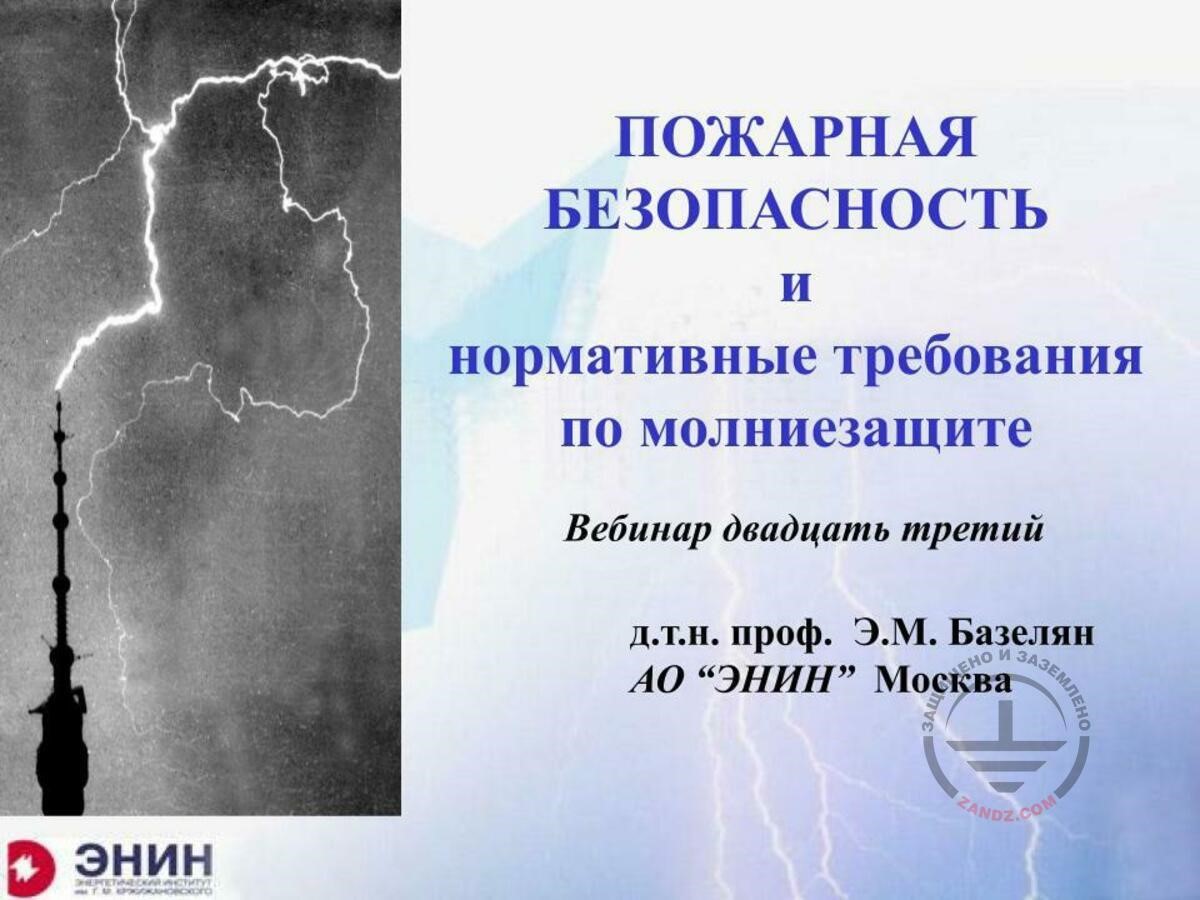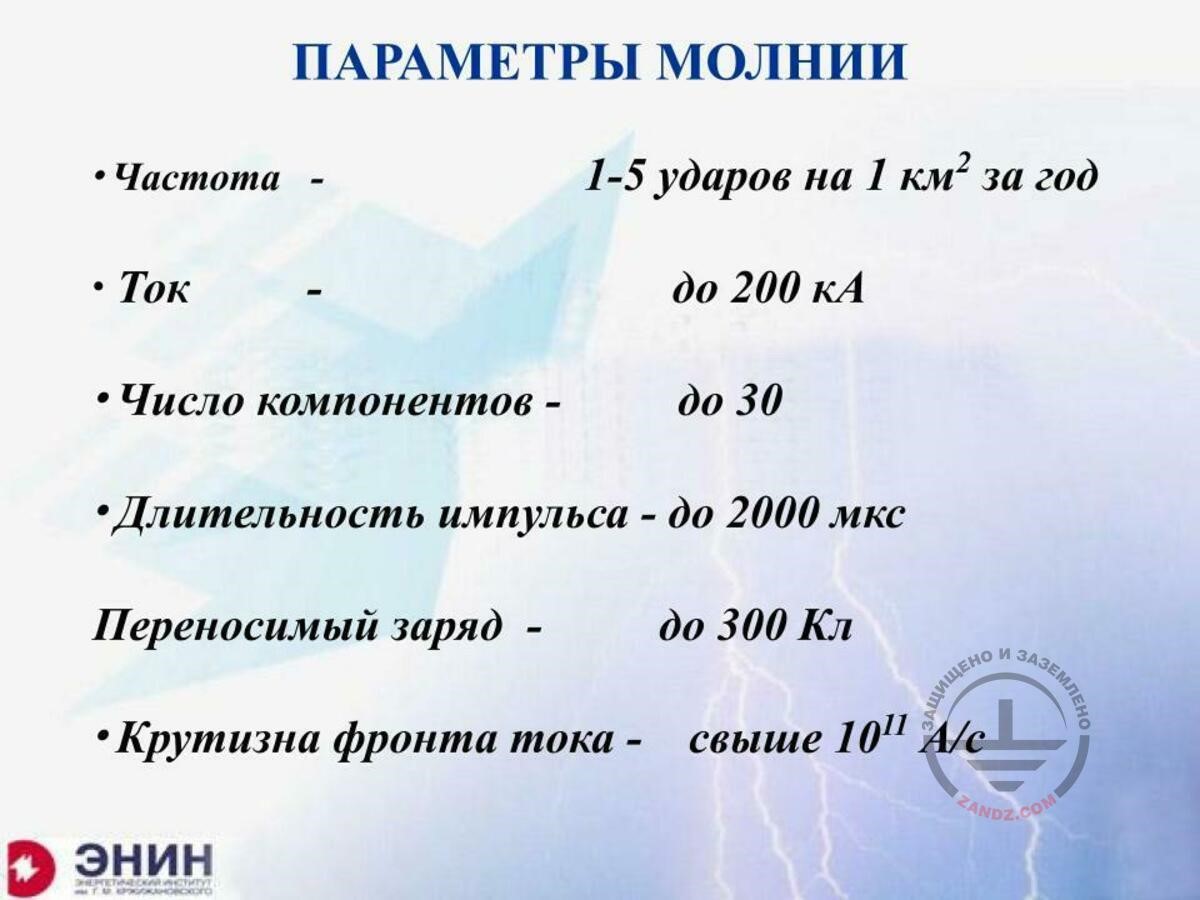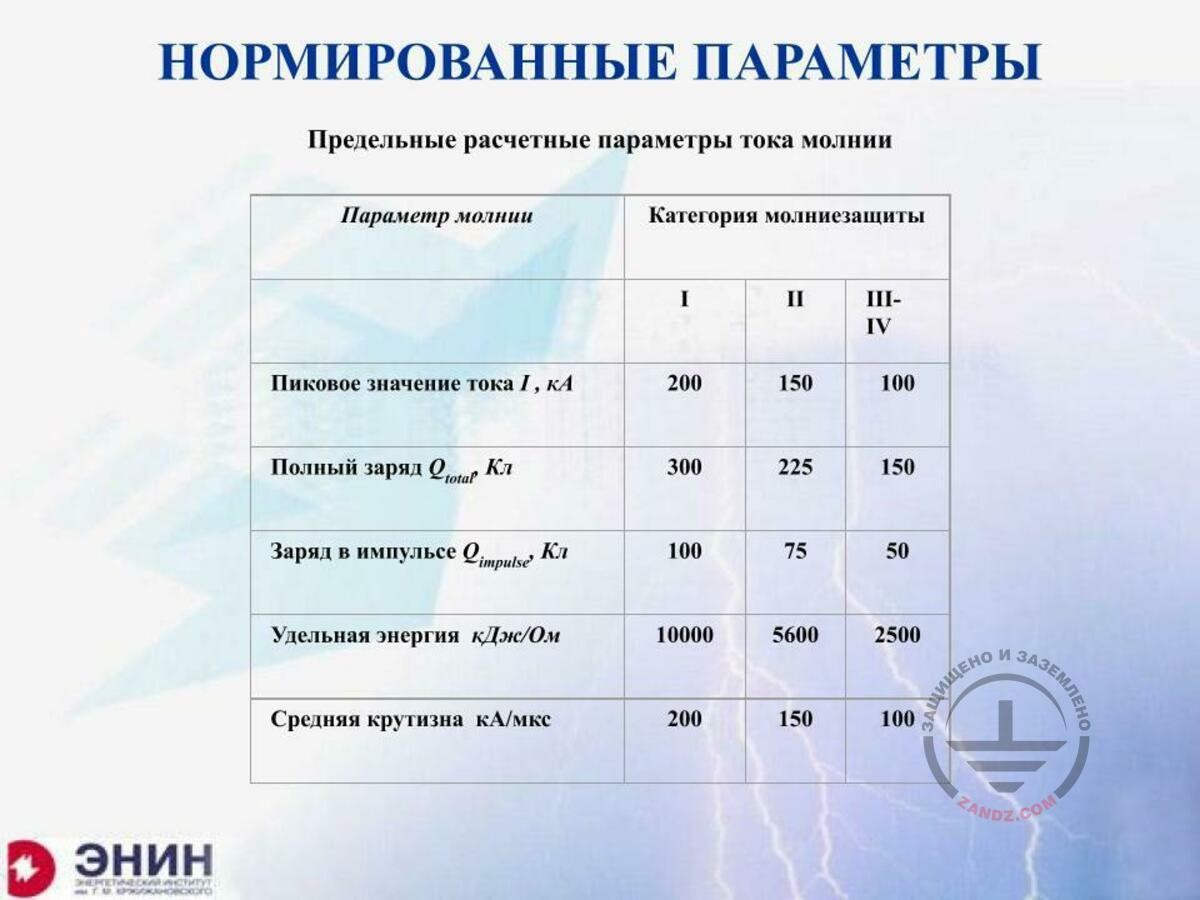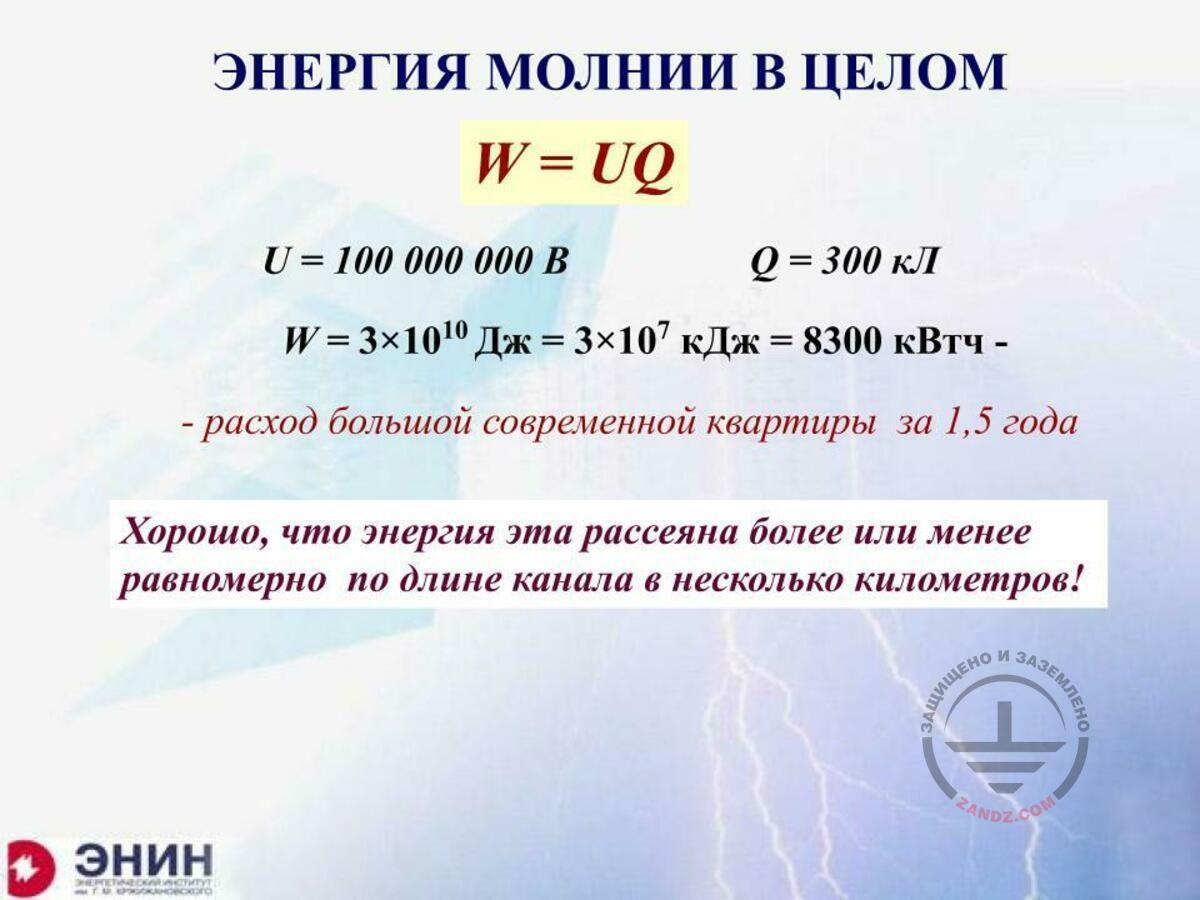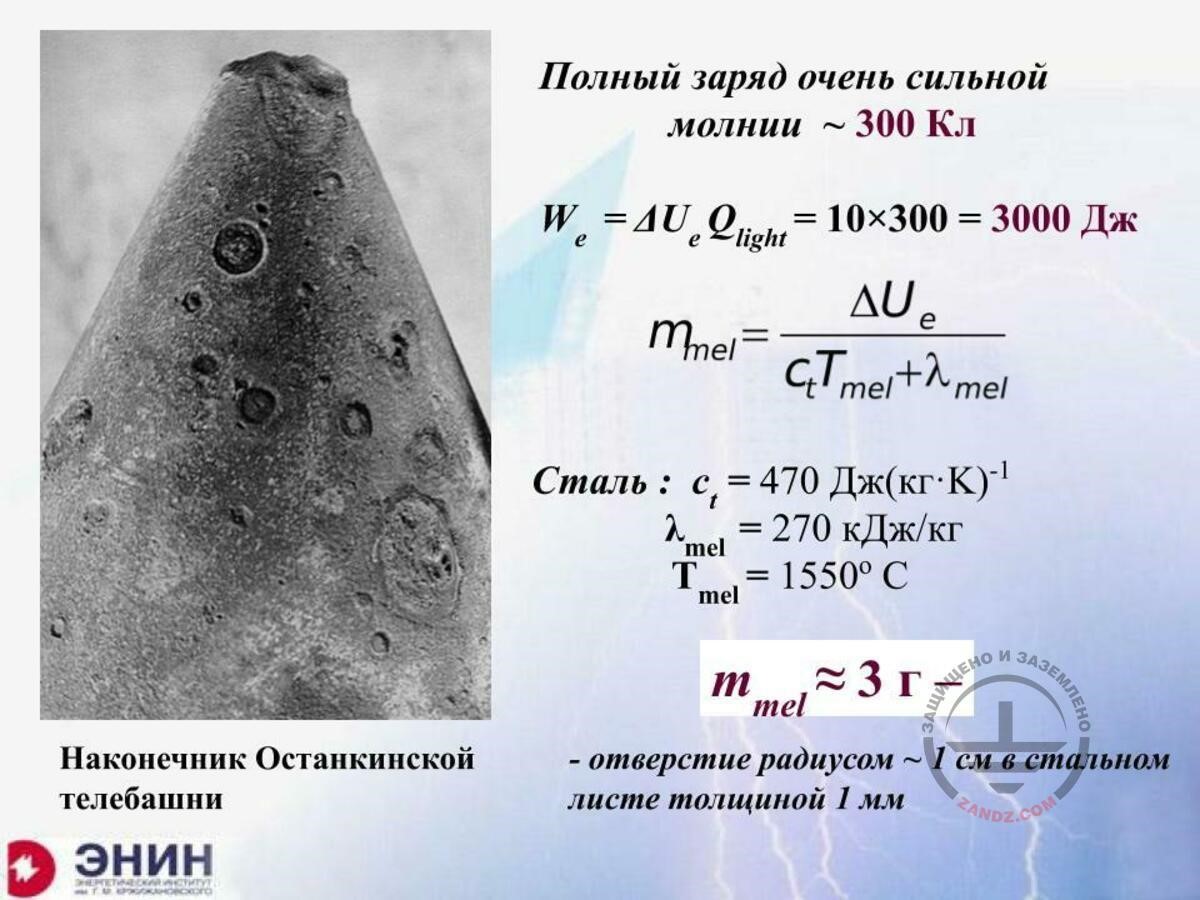The twenty-third webinar of the "Earthing and Lightning Protection: Design Issues and Problems" series.
(held on October 10, 2018 at 11:00 Moscow time)
1080p full screen watching is recommended.
Although the lightning has got the temperature of 30,000 K, it is a poor fire-setter. The combustion products are effectively thrown out by the supersonic air blast that is so strong that is can stop the aircraft turbine. However, fires occur and the multi-component lightnings are in charge of them. In the pauses between the components, the current of about 100 A flows along the lightning channel. It does not result in the air blast but supports the channel temperature of about 6,000 K, which is almost the same as in the welding arc.
The instructions of the fire inspection have introduced many issues to the regulatory documents associated with the lightning protection. And not all of them are considered indisputable today. We have to talk about the feasibility of installing standalone lightning arresters, about the use of thin modern metal roofs, about laying the current collectors on the surfaces of flammable decorative panels of the building walls, about the danger of incomplete plasma channels that are in contact with the flammable gaseous emissions into the atmosphere.
Finally, we have to get back to the evaluation of efficiency of lightning protection grids, which are still widely used in the urban construction, and to the danger of spark channels that are spread along the soil surface for several dozens meters. Here, we have got enough mess and unreliable measures that have almost become traditional in the practical lightning protection.
Webinar text. Page 1
Fast navigation by slides:
Page 1:
1. Fire safety
2. Lightning parameters
3. Lightning is a poor fire-setter!
4. Rated parameters
5. Lightning energy as a whole
6. Thermal impact of lightning current
7. Emergency mode: one current collector is damaged
8. Welding is preferred to contact connections
9. Tip of the Ostankino Tower
Page 2: >>
10. Spark discharges along the soil surface
11. Incomplete discharges
12. What discharge may put the gaseous mixture on fire?
13. Regulatory requirements
14. Multiple lightning arresters
15. Standalone lightning arresters
16. Lightning protection issues
17. Category III lightning protection
Page 3: >>
18. Spark-proof lightning arrester
19. Wire lightning arresters
20. Earthing of lightning arresters of explosive facilities
21. Isolation arresters
22. Use in the explosive zones
23. Band clamps
24. DEHNpipe SDPs for spark-proof circuits
25. Questions and answers
26. Thank you for attention
Approximate reading time: 57 minutes.
| ПОЖАРНАЯ БЕЗОПАСНОСТЬ и нормативные требования по молниезащите | FIRE SAFETY and regulatory requirements to lightning protection |
| Вебинар двадцать третий | The twenty-third webinar |
| Д.т.н. проф. Э.М. Базелян | Dr.Sc. (Eng.), Prof. E.M. Bazelyan |
| АО «ЭНИН» Москва | “ENIN” AO, Moscow |
– Good afternoon, Eduard Meerovich! Let's begin.
– Good afternoon! Let's do it!
– Today, we have got a webinar titled "Fire Safety and Regulatory Requirements to Lightning Protection". The speaker is an acknowledged expert in the lightning protection and earthing, professor Eduard Meerovich Bazelyan. Let me remind you that our next webinar is scheduled for November 7, and it is titled: "Future of Lightning Protection. An Optimistic Version". The link for registration will be provided in the chat. Register so that not to miss the next events. I also remind you that we will hold a series of webinars dedicated to the BIM design. The next webinar of this series will take place on October 17, i.e. in a week, also on Wednesday, at 11:00. The link is provided in the chat and you may register for it. You may also get the information on new events in our social media groups, e.g., in Facebook and Vkontakte. The links are provided in the chat. Join the social media groups or register on the website. Do not miss the relevant events. Here are some organizational aspects: our webinar will take 70 to 90 minutes depending on your activity and the number of your questions. I also ask you to be active, ask questions, and write in the chat. We will answer your questions at the end of the webinar. If I can answer the questions in the chat quickly, I will write answers to you, but all other questions will be answered at the end of the webinar. It is better to write questions in the "Questions" tab. Indicate the slide or the speaker's phrase they relate to. I will also add that we will certainly make the video with the webinar. We had some technical issues when recording the previous webinar, but we have solved them. A couple of days ago, we published the video on the website and on our YouTube channel. Therefore, those who did not see it can watch this video. And we will also have a video for this webinar. Probably this will not be done very quickly but I hope it will take two or three days. That is it. I have finished my introductory word and I give my turn to the speaker. Eduard Meerovich?
– Good afternoon, good morning! What do I want to begin with? I would like to answer all of your questions, but frequently, the questions asked are absolutely unclear for me. For example, the questions are of the following kind: "Can we install the Class II SDPs in the "XYZ 128" system?" But I do not know the "XYZ 128" system at all, so I cannot answer this question. And such questions are frequently asked. If you ask a question, it must contain the initial data so that a person could provide a specific and useful answer. I ask you to do that. Now, with regards to our webinar today. We have finally come back to the lightning protection outcome. The lightning protection began from fire safety. Mikhail Lomonosov wrote: "...That if we know the rules provided by the Glass, We can take away the thunder from our houses". By the word "Glass", he meant the electrostatic machine that was, at that time, the only source of high voltage. Surely, Mikhail Lomonosov was an optimist because, today, when we have the generators for many millions volts are available, we still cannot take the lightning away entirely from our houses. And these questions are rather serious.
| ПАРАМЕТРЫ МОЛНИИ | LIGHTNING PARAMETERS |
| Частота – 1-5 ударов на 1 км2 за год | Frequency — 1–5 strikes per 1 km2 per year |
| Ток – до 200 кА | Current — up to 200 kA |
| Число компонентов – до 30 | Number of components — up to 30 |
| Длительность импульса – до 2000 мкс | Pulse duration — up to 2,000 mcs |
| Переносимый заряд – до 300 Кл | Transferred charge — up to 300 C |
| Крутизна фронта тока – свыше 1011 А/с | Current front steepness — over 1011 A/s |
You can see the slide on the screen showing how often this occurs. About 3 to 4 strikes per 1 km2 per year is the lightning frequency in the territory of the Russian Federation. The average currents are about 30 kA, the maximum currents are 200 kA; with these currents, the lightning channel temperature may not be less than 30 thousand degrees. And when I am talking about this crazy temperature, I must note that the lightning is a poor fire-setter. The lightning works on the principle that it does everything by itself. Because by creating a completely crazy supersonic air blast, the lightning will wipe off almost all combustion products from the point of the channel contact. Therefore, the lightning is not a very good fire-setter. It would not have set anything on fire at all, if it did not have multiple components. But about 85% lightnings contain multiple components that may go along the same channel. In the pauses between the components, the lightning current is very small, but it is small from the viewpoint of the lightning. Because the current of the pause between the components is about 100 A. As a result of this, the channel cools down to the temperature of about 6,000 K, i.e. it is the temperature of the welding arc.
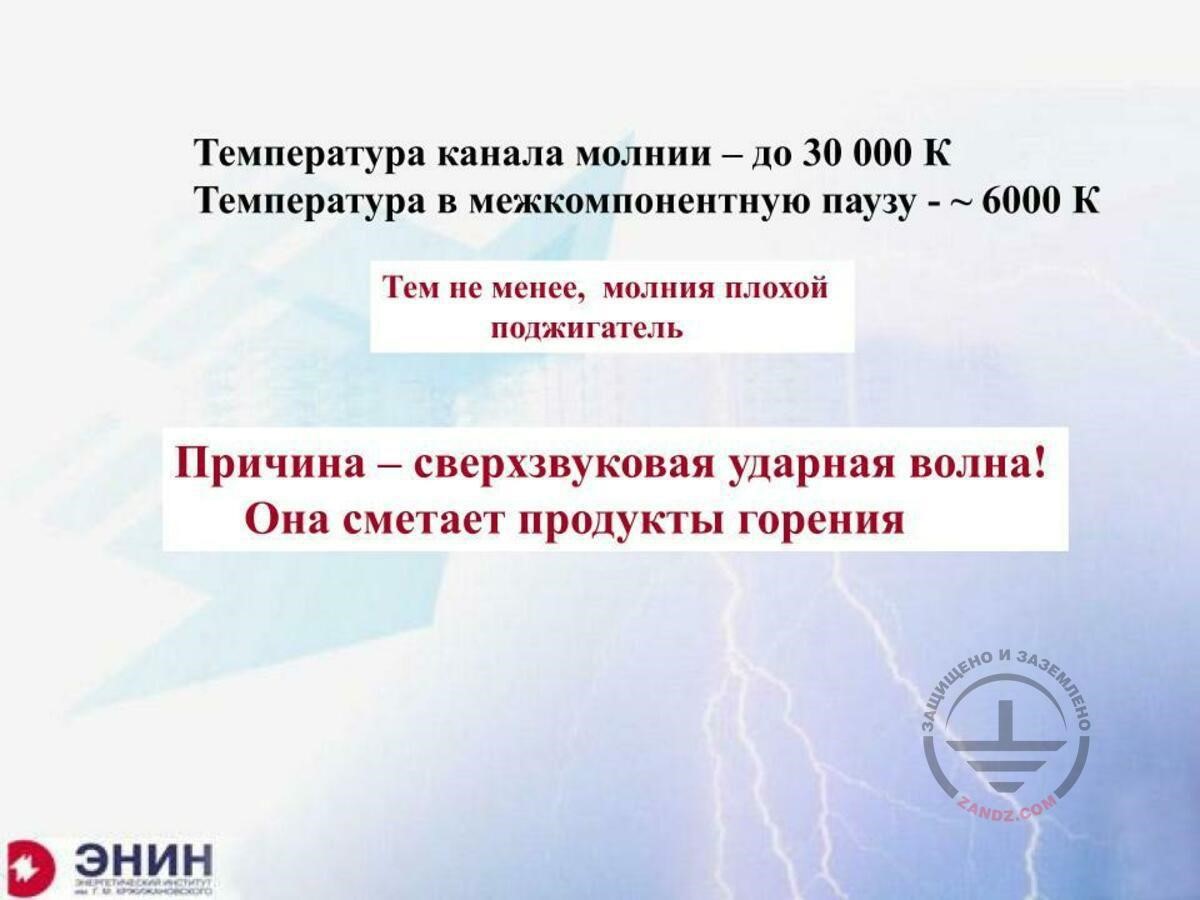
Lightning is a poor fire-setter!
| Температура канала молнии – до 30 000 К | The lightning channel temperature — up to 30,000 K |
| Температура в межкомпонентную паузу - ~ 6000 К | Temperature in the pause between the components is ~ 6,000 K |
| Тем не менее, молния плохой поджигатель | However, lightning is a poor fire-setter |
| Причина – сверхзвуковая ударная волна! | The reason is in the supersonic air blast! |
| Она сметает продукты горения | It wipes out all combustion products |
And there is no air blast in the pause between the components. It is precisely for this reason, the lightning sets the objects on fire, and the fact that the air blast exists and it is a rather serious blast, is confirmed by the experience of the aviation equipment operation. Because the aviators know very well such term as the engine stall, when the air blast going from the lightning that struck the aircraft air intake passes through the turbine, wipes out all combustion products and, as a result, the turbine just stalls. This is a rather typical situation. But I do not want you to conclude that you need to avoid civil aircrafts. Civil aircrafts do not virtually experience the engine stall because the engines are hidden in the poles on the wings, and the lightning does not usually reach them. The engine stall is a prerogative of a military aviation.
| НОРМИРОВАННЫЕ ПАРАМЕТРЫ | RATED PARAMETERS |
| Предельные расчетные параметры тока молнии | Limited estimated parameters of the lightning current |
| Параметр молнии | Lightning parameter |
| Категория молниезащиты | Lightning protection category |
| Пиковое значение тока I, кА | Peak value of current I, kA |
| Полный заряд Qtotal, Кл | Full charge Qtotall, C |
| Заряд в импульсе Qimpulse, Кл | Charge in pulse Qimpulse, C |
| Удельная энергия кДж/Ом | Specific energy, kJ/Ohm |
| Средняя крутизна кА/мкс | Average steepness, kA/mcs |
You know well the rated lightning parameters. And they are rated such that even for the third and the fourth lightning protection category you have got a calculation current you need to consider; it is 100 kA. By the way, 100 kA is the current of the lightnings, the number of which does not exceed 5%. The charge that can be carried by this lightning is about 150 C, and the specific energy is about 2,500 kJ/Ohm. It means that the energy that is provided by a very weak lightning is rather significant
| ЭНЕРГИЯ МОЛНИИ В ЦЕЛОМ | LIGHTNING ENERGY AS A WHOLE |
| В | V |
| Кл | C |
| кВтч | kWh |
| кДж | kJ |
| Дж | J |
| -расход большой современной квартиры за 1,5 года | - consumption in a large modern apartment for 1.5 years |
| Хорошо, что энергия эта рассеяна более или менее равномерно по длине канала в несколько километров! | It is great that this energy is dissipated more or less uniformly along the length of the channel for several kilometers! |
Now, what energy does the lightning carry? In terms of energy the lightning carries, the potential between the cloud and the earth should be multiplied by the charge that is carried by the lightning. This potential may not be less than 100 mln V, and the charge cannot reach 300 C. As a result, the lightning carries the energy that reaches 10,000 kWh of electrical energy. This is not much, because, if you consider an apartment in the building wherein most of us live, we will have the electrical energy sufficient for about 1.5 years of its illumination. But fortunately, this energy is distributed in the space between the cloud and the earth and, therefore, this energy cannot be taken into consideration when calculating any thermal lightning impacts. It would have been a great mistake. If you take this energy and start calculating what would happen to the conductor from this energy, how a metal wall may melt as a result of this energy, what mechanical impacts may be provided by this energy. It will be a great mistake. Because the lightning distributes this energy in all space between the cloud and the earth.
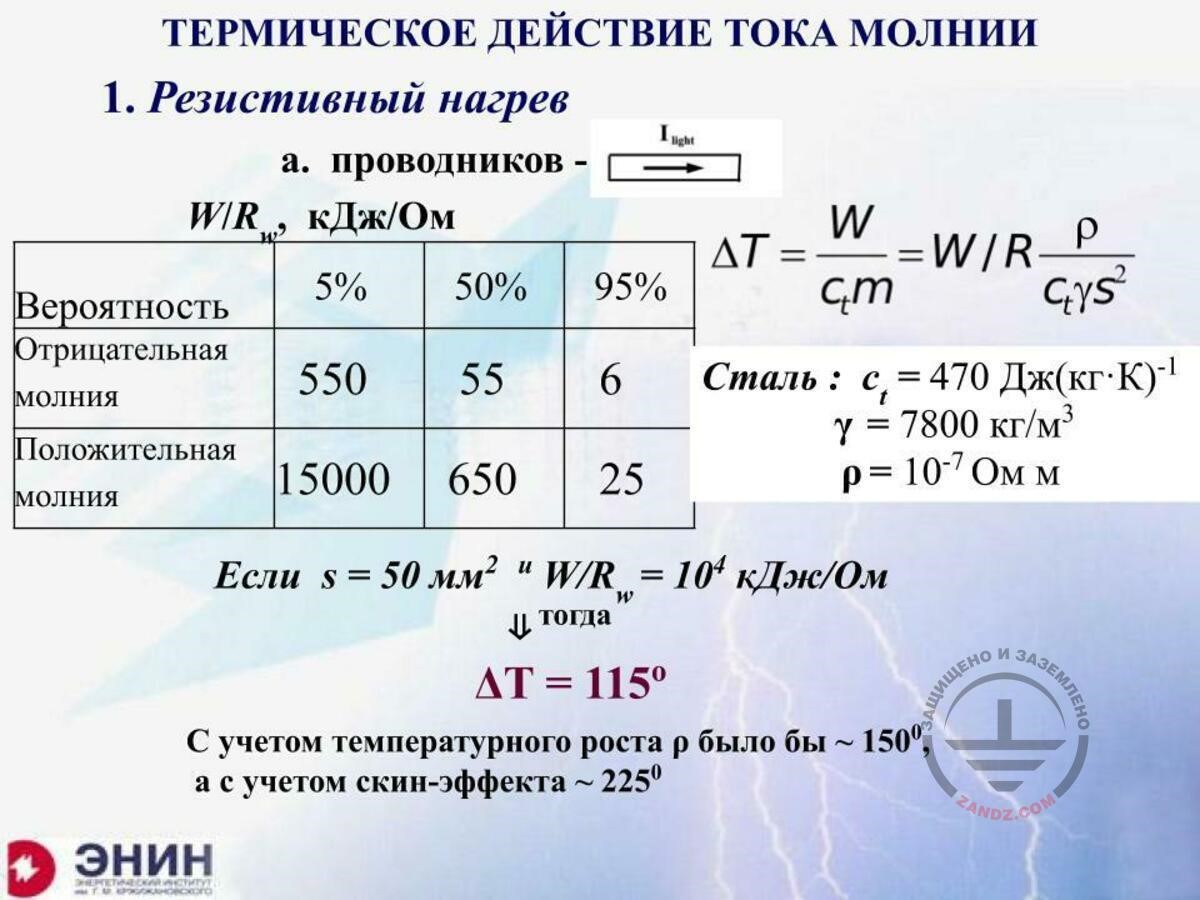
Thermal impact of lightning current
| ТЕРМИЧЕСКОЕ ДЕЙСТВИЕ ТОКА МОЛНИИ | THERMAL IMPACT OF LIGHTNING CURRENT |
| 1. Резистивный нагрев | 1. Resistive heating |
| a. проводников | a. of conductors |
| кДж/Ом | kJ/Ohm |
| Вероятность | Probability |
| Отрицательная молния | Negative lightning |
| Положительная молния | Positive lightning |
| Дж(кг К)-1 | J(kg K)-1 |
| кг/м3 | kg/m3 |
| Ом м | Ohm m |
| Если | If |
| и | and |
| тогда | then |
| С учетом температурного роста ρ было бы ~ 150°, а с учетом скин-эффекта ~ 225° | Taking into account the temperature growth ρ, it would be ~ 150° and considering the skin effect, it would be ~ 225° |
And let's calculate the energy that is spent for dangerous things. The first thing is the thermal conductor heating. We are talking about the current with a set value that flows along the conductor with a certain resistance. As a result of this, the energy is released that is equal to the current square multiplied by the conductor resistance and the time of its flowing along this conductor. If you take all of this energy and consider, for example, the standard steel conductor with a certain heat capacity and a certain resistivity, we will have the following. If we perform calculations for steel, and major part of the current collectors are made of steel, if we make calculations for steel of 50 mm2 with the rated resistance, we will have the following thing: at the maximum energy that may be released by the lightning in this conductor, the overheating will reach only 110 to 115°. Now, if you start nit-picking and say: "What kind of calculation is this? I know that the resistivity increases when steel is heated. And I know that, due to skin effect, the current flows virtually only along the thin external surface of a steel conductor". If I pile it up in a heap, then I will obtain that one conductor may be overheated to the temperature of about 220 to 230 degrees, but you must remember that we never use one current collector. Because, according to our standards, we need to have at least two current collectors.
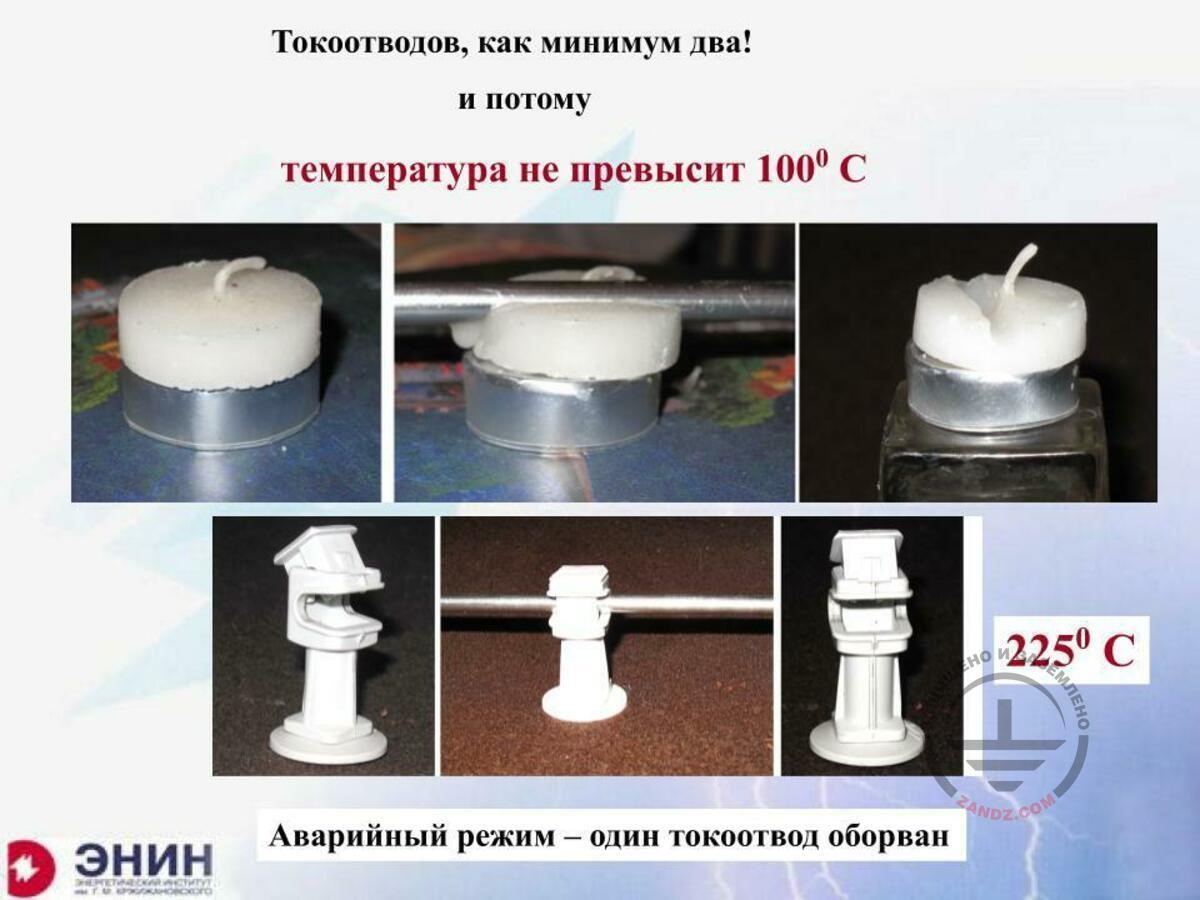
Emergency mode: one current collector is damaged
| Токоотводов как минимум два! | There are at least two current collectors! |
| И потому | Therefore, |
| Температура не превысит 100°C | Temperature will not exceed 100°C |
| Аварийный режим – один токоотвод оборван | Emergency mode: one current collector is damaged |
What do we have as a result of this? I had a very interesting discussion with a representative of a company who said the following words: "There are lightning protection products and there are holders for current collectors in the market. These holders for current collectors are manufactured from polypropylene. It is a crime to buy and manufacture such current collectors because the current collector will heat, melt this polypropylene and, as a result, you will have the emergency situation and likely a fire". Since it happened during the New-Year holidays, I had a candle. And I heated the current collector to 100 degrees and placed it on this candle. You can see the result in this slide. Here you have got a trace in the middle of the candle, and there is nothing else. After that, I used the electrical oven and heated the current collector to 225 degrees. It is an upper temperature limit we can use. I placed the current collector into the oven, held it until it cooled down, took out, and could not even see the darkening of polypropylene. It means that we cannot say that the fire might occur due to the current collectors overheating. However, the fire safety requirements are such that the current collectors should not contact the surface of certain decorative materials that can be put on fire. This is the requirement we cannot ignore. You may hide the current collectors under the brick laying, but the fire fighters prohibit categorically to hide them under the cladding or siding. You can see that the situation is like this, but unfortunately, we cannot ignore fire safety requirements in this case.
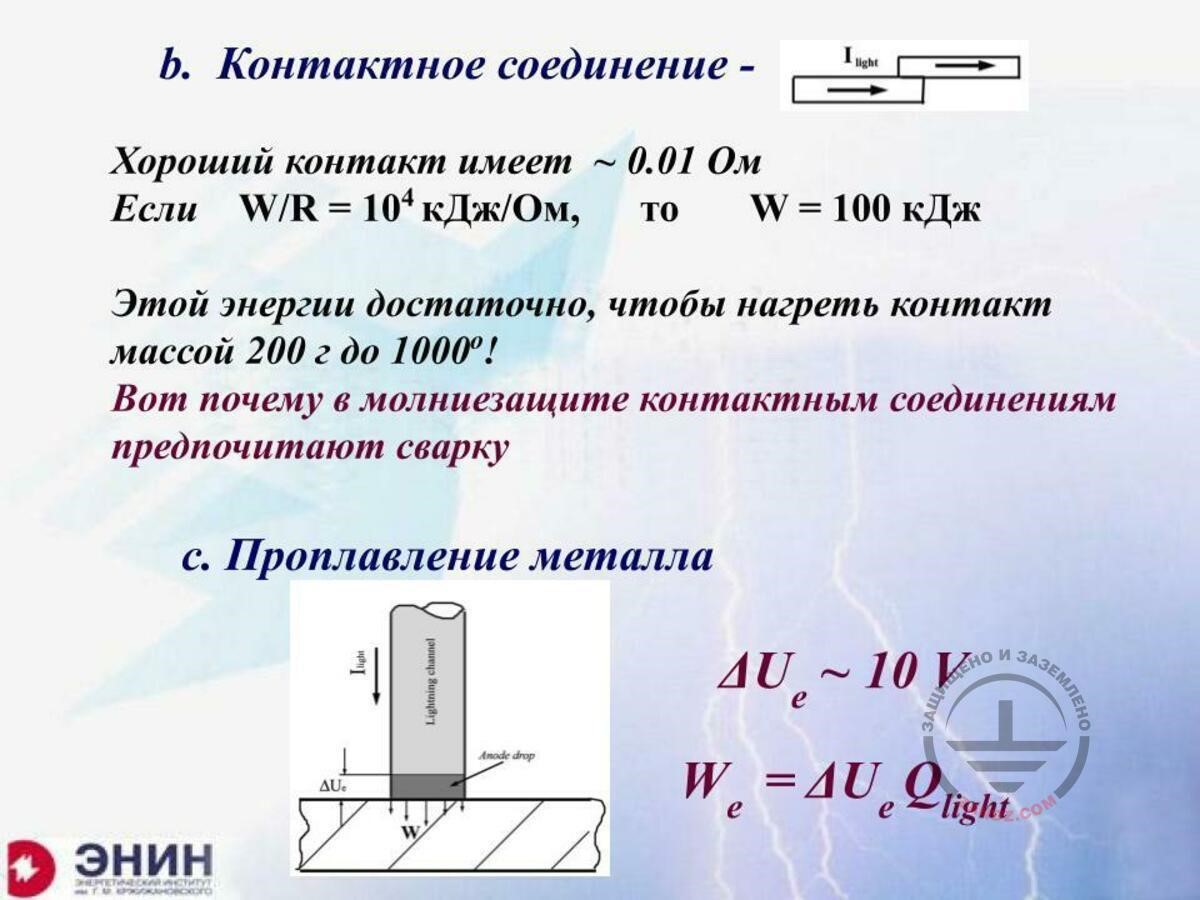
Welding is preferred to contact connections
| b. Контактное соединение - | b. Contact connection - |
| Хороший контакт имеет ~ 0,01 Ом | A good contact has got ~ 0.01 Ohm |
| Если | If |
| кДж/Ом | kJ/Ohm |
| То | then |
| кДж | kJ |
| Этой энергии достаточно, чтобы нагреть контакт массой 200 г до 1000°! | This energy is enough to heat the contact having the weight of 200 g up to 1,000°! |
| Вот почему в молниезащите контактным соединениям предпочитают сварку | That is why the welding is preferred to contact connections in the lightning protection |
| с. Проплавление металла | c. Metal melting |
The second situation is even tougher. It is associated with that the current collector along which the lightning current goes, may not be continuous. It may have welded connections, then it is like a continuous connection, but it may also have a contact connection, i.e. using bolts. Today, this situation is real because the bolt connections are increasingly more often used in the lightning protection. Our Russian requirements are such that the transient resistance of the bolt connection should be not more than 0.05 Ohm. Probably this connection of 0.05 Ohm is not very good. Because, if I perform calculations, what will I obtain for this connection? If I use the contact of 0.01 Ohm and calculate the energy that is released here with the strongest lightning, then it appears that this connection will provide about 100 kJ. 100 kJ may heat the conductor having the weight of about 200 grams to about 1,000 degrees. And 1,000 degrees are dangerous. And now we have to to worry about what we should do in this situation. The requirements are even tougher in Europe. In Europe, the bolt connections are only allowed when you have got a transient resistance of a bolt connection or some other clamp of less than 0.003 Ohm. And 0.003 Ohm should be met in case this connection is not just in the open air, but is located in the open air in a contaminated atmosphere containing acidic and sulphur compounds. If we adopt such standards, then the temperature in no way exceeds about 300 degrees, and it is not likely that the fire will start upon a contact with cladding. And one more point. If the lightning channel contacts a flammable surface, what is released in this case? The calculation made here is approximately as follows. The energy is released that goes to the near-electrode voltage drop. This near-electrode voltage drop is only 10–12 V for the majority of metal surfaces. If you multiply these 10–12 V by the charge that flows through this surface, then it will turn out that a certain amount of energy will be released, about 3,000 kJ.
| Полный заряд очень сильной молнии ~ 300 Кл | Full charge of a very strong lightning ~ 300 C |
| Дж | J |
| Сталь: | Steel: |
| Дж(кг К)-1 | J(kg K)-1 |
| кДж/кг | kJ/kg |
| 3 г | 3 g |
| - отверстие радиусом ~ 1 см в стальном листе толщиной 1 мм | - a hole with a radius of ~ 1 cm in the steel sheet having a thickness of 1 mm |
| Наконечник Останкинской телебашни | Tip of the Ostankino Tower |
What can we use this for? It can be used to melt about 3 g of metal, if it is steel. You can see the photo of the flagstaff tip of the Ostankino Tower that has been taken in good time to see how it was damaged after the lightning strike. The figure you can see on the screen has a scale of about 1 : 1, and the burnings here have a diameter of up to one centimeter, and a depth of about 1 to 1.5 mm. Therefore, in all regulatory documents for lightning protection with no exceptions, the following rule is provided: if you have a surface of 4 mm thick for steel, then this surface will not melt through and will not overheat from the internal side, in no event. Such surface may be considered as absolutely safe in terms of the lightning strike. The lightning current will spread across this surface and nothing will happen. OK, what if this surface is thin? Imagine that you have got a metal tile. According to the effective standards, it is permitted to use this metal tile as the lightning arrester if its thickness is not less than 0.5 mm. The lightning will melt such metal tile for sure. And 3 g of melted metal will get onto your roof-sheathing under the tile. Therefore, the standards provide the following: you may use the metal tile as the lightning arrester if its roof-sheathing underneath is not flammable. For a long time, I have been asking fire fighters about what roof-sheathing can be considered inflammable? In Russia, especially in private houses construction, the metal is usually used. People are ready to spend money for impregnating this metal with the respective anti-burning compound to eliminate the possibility of setting it on fire. Tell me please, can this roof-sheathing be considered non-flammable after such treatment? The opinions were different here. I could not obtain the precise answer from fire fighters. But due to the fact that I live in such a wooden house and this house is very old and it was built 50 years ago, I came up to the attic and looked at what things are stored there. After that I understood that if the metal gets onto these things, we will not be able to avoid the fire. Because so many things were brought there during these 50 years. Therefore, I have the next tip for you. If you decide on how to protect the house with the modern roof made of metal tiles or metal profile that is a little bit thicker. I recommend you to avoid the lightning strike into this roof. Install lightning arresters and protect the surface from the direct lightning strike. I can tell you the value of the reliability of protection you must use. If you build a typical house, then it will hardly be more than 10 meters high. Therefore, your house will get more than one strike in 30 or even 50 years. If you provide the lightning protection using the lightning arresters with the reliability of 0.9.
Next page >>
slides from 10 to 17
Related Articles:
 5. Boundary between soil and air
5. Boundary between soil and air
 6. How to do that?
6. How to do that?


